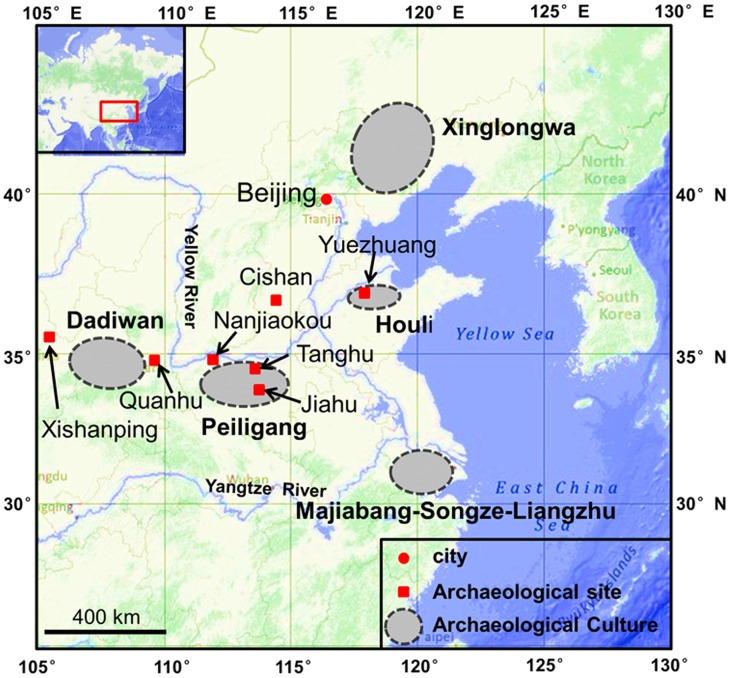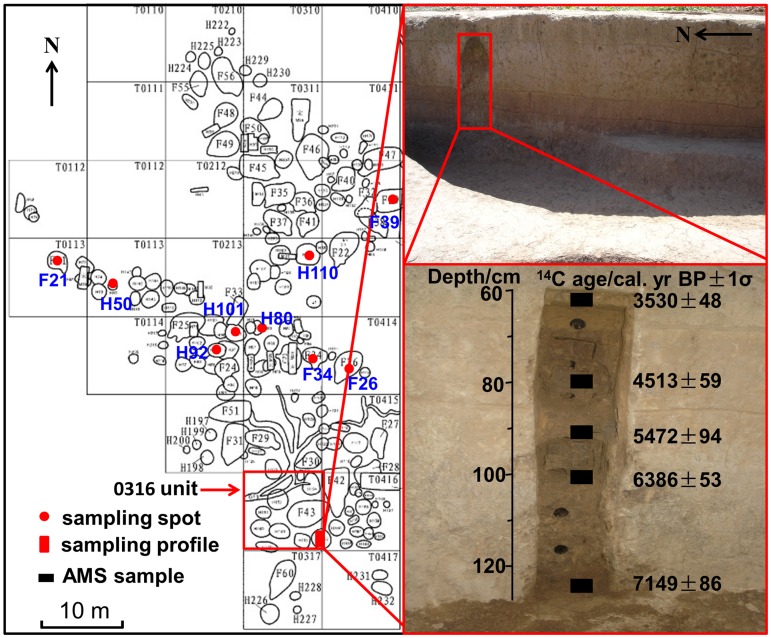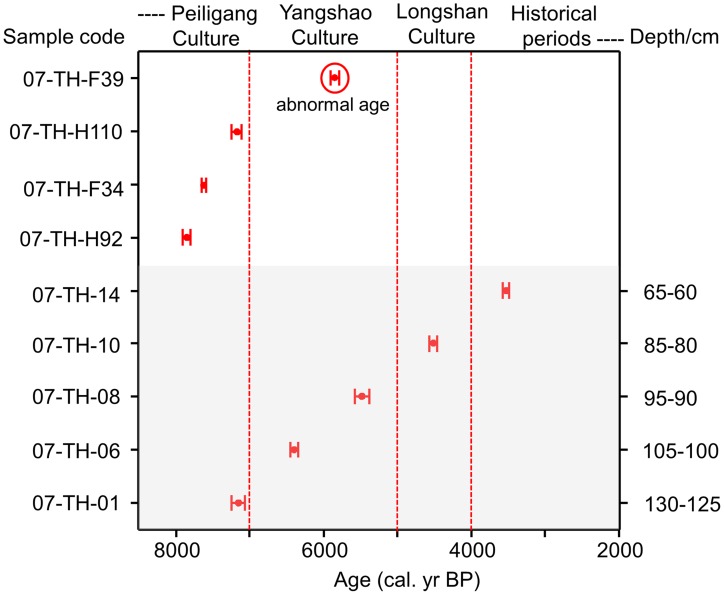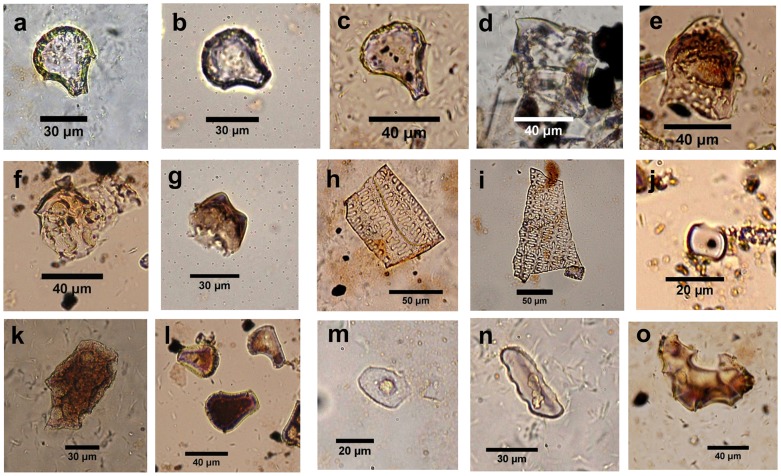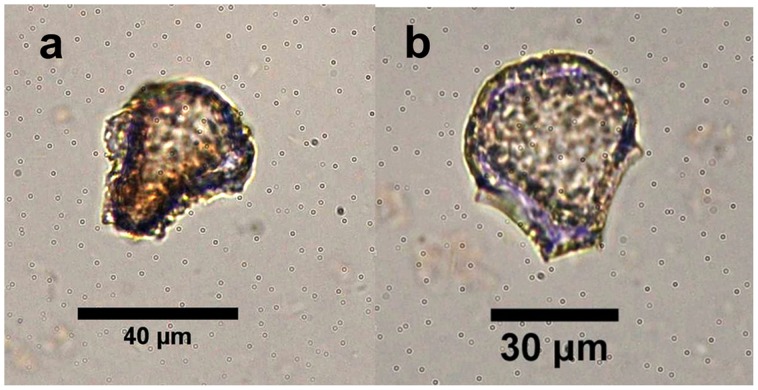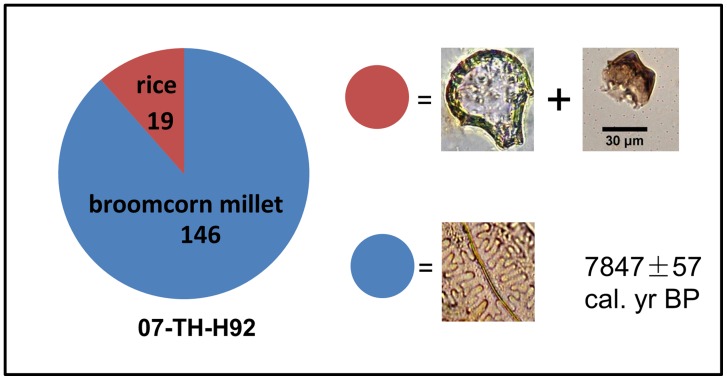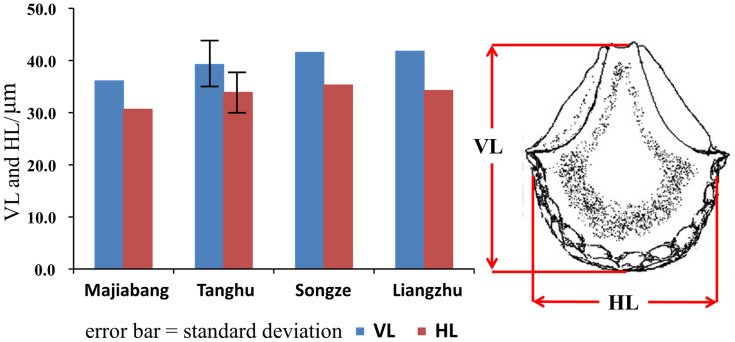Abstract
The Peiligang Culture (9000-7000 cal. yr BP) in the Middle Yellow River region, North China, has long been considered representative of millet farming. It is still unclear, however, if broomcorn millet or foxtail millet was the first species domesticated during the Peiligang Culture. Furthermore, it is also unknown whether millet was cultivated singly or together with rice at the same period. In this study, phytolith analysis of samples from the Tanghu archaeological site reveals early crop information in the Middle Yellow River region, China. Our results show that broomcorn millet was the early dry farming species in the Peiligang Culture at 7800 cal. yr BP, while rice cultivation took place from 7800 to 4500 cal. yr BP. Our data provide new evidence of broomcorn millet and rice mixed farming at 7800 cal. yr BP in the Middle Yellow River region, which has implications for understanding the domestication process of the two crops, and the formation and continuance of the Ancient Yellow River Civilization.
Introduction
It is generally believed that the Peiligang Culture (c. 9000-7000 cal. yr BP) represents a key cultural transition complex from a mobile hunter-gatherer society to a dry farming-based Neolithic culture in the Middle Yellow River region [1]–[3] (Figure 1). Crop remains from the Peiligang Culture have rarely been found before [4]–[6], however, thus several critical archaeobotanical questions related to cultivated crop assemblages are still unresolved. For example, because millet is an agronomic, not taxonomic, group with several genera, 1) what genus and species of millet, broomcorn (Panicum miliaceum) or foxtail (Setaria italica), was first cultivated in the Peiligang Culture and 2) whether millet was cultivated singly or together with rice during the Late Peiligang period (8000-7000 cal. yr BP) [4], [7], [8]?
Figure 1. Archaeological sites and related cultures mentioned in the article.
The map cited from http://maps.ngdc.noaa.gov/viewers/bathymetry/.
Millet has been considered an important part of the crop assemblage at Peiligang Cultural sites [4], but work to date has only provided limited evidence of cultivated millet. Few carbonized crop grains with neither precise ages nor substantial identification from Late Peiligang Culture sites have been identified as possibly foxtail millet [5], [9]–[11]. Some starch grains on stone tools from Peiligang Cultural sites recently were identified in general terms as millet type [7], [8]. So far, no solid evidence for millet can be used to discuss what kind of millet was first cultivated in the Peiligang Cultural period. Thus the millet domestication process is still unclear.
Rice (Oryza sativa) has been regarded as a native crop in the Mid-Lower Yangtze River region of China [12]–[14], whereas its presence in the Yellow River region was considered an introduction, because rice evidence was recently found at the Jiahu (c. 9000-7800 cal. yr BP) and Yuezhuang sites (Houli Culture, c. 8000-7800 yr BP) in the Mid-Lower Yellow River region [11], [15], [16]. No matter whether or not it is native or introduced, rice evidence is absent after the Jiahu and Yuezhuang periods at Peiligang Culture sites (c. 8000-7000 cal. yr BP), yet appears again in the middle Yangshao sites (6000-5500 cal. yr BP) in North China [17], [18]. This 2000-year gap of evidence of rice cultivation in the Middle Yellow River region [4], [17] makes it difficult to understand the domestication process, how domesticated rice spread, and how it was combined with millet in mixed farming at this period.
The mixed farming of millet and rice was a significant event in the process of agricultural development. Due to the fact that either millet or rice, not both, has been found at Neolithic sites in Central-North China [11], questions of where and when mixed farming was established still remain. More archaeobotanical evidence from Neolithic sites, especially Peiligang Culture sites, is needed to resolve these questions.
Evidence of early farming is based primarily on macrofossil remains, which are limited for the time when the Peiligang Culture flourished, mostly due the remarkably dissolution of organic material in loess regions, including the Peiligang Culture sites, dominated by a warm and wet environment. Unlike macrofossils, phytoliths are extremely durable silica replicas of plant cells [19], [20], which are found in preserved in various environments without serious decay, even in extremely hot and wet areas, such as in tropical forests [21]. Phytolith analysis is a useful technique to identify certain genera or species of plants [19], [20], especially for identifying broomcorn millet, foxtail millet, and related wild ancestors [22]–[24]. In this study, phytolith analysis was conducted on samples from a Peiligang Culture site, Tanghu, in the Middle Yellow River region of southern North China. Our analyses provide new data for understanding the cultivation and spread of broomcorn millet and rice, and the mixed farming of the two crops in Peiligang Cultural period.
Materials and Methods
The Tanghu site (113°10′43″–113°11′22″ E, 34°7′24″–34°8′20″ N) is located in Henan Province, southern North China (Figure 2). A prehistoric culture, Peiligang Culture, developed there and extended into the Shang and Zhou dynasties [25], [26]. This archaeological site covers c. 20 ha and has been considered the largest Peiligang settlement yet discovered [26]. Forty-one semisubterranean round houses (some with double rooms) and 169 pits were found in a 2007 excavation [26]. Unfortunately, no crop remains were found during macrofossil flotation (personal communication with Juzhong Zhang). In this current study, we collected two types of samples for phytolith analysis. One was from the profile of an archaeological layer from excavation Unit 0316, the other was from deposits from pits and houses (Figure 2). All necessary permits were obtained for the described field studies from Zhengzhou Provincial Cultural Relics and Archeology Research Institute.
Figure 2. Sampling locations from the Tanghu site.
The plan positions of archaeological units is after Xin et al. (2010).
The deposits from profile (130 cm in thickness) can be divided into five layers from top to bottom according to the structure of the stratigraphy, soil color, and the archaeological remains: 1) 0–22 cm, modern cultivated layer; 2) 22–66 cm, light yellow loess and loose deposits containing ceramic fragments; 3) 66–85 cm, brown soil, dense deposits containing charcoal and ceramic fragments; 4) 85–98 cm, red-brown soil, very dense deposits of red burned soil and charcoal; and 5) below 98 cm, pit deposit (pit H192). We successively collected the samples at 5-cm intervals from the eastern wall of excavation Unit 0316. In total 14 samples were taken from the 60 to 130 cm section, including five AMS dating samples (Figure 2).
Another nine samples were collected from other pits (H110, H101, H92, H80, H50) and houses (F39, F34, F26, F21-4) at the south part of the Tanghu site. These samples were dense deposits of red-brown, and rich in charcoal. Samples H110, H92, F39, and F34 were also used for AMS dating (Figure 2).
Phytolith analysis was conducted on all 23 samples (c. 2 g) combining the techniques described by Piperno [27] and Runge et al. [28] with slight modifications. The procedure consisted of deflocculating with 5% sodium pyrophosphate (Na4P2O7), then treatment with 30% hydrogen peroxide (H2O2) and cold 15% hydrochloric acid (HCl), separation using zinc bromide (ZnBr2, density 2.35 g cm3) heavy liquid, and mounting on a slide using Canada Balsam. Phytolith counting and identification were performed using a Leica microscope with phase-contrast at 400 magnification. In most samples, more than 300 phytoliths were counted. Identification was aided by the use of reference materials [29]–[31] and published keys [9], [19], [32]–[34].
Results
Ages of AMS dating are given in Figure 3. Nine 14C ages, dated using paleosoil rich in charcoal, cover the period from 7840 to 3500 cal. yr BP. Most of ages are consistent with archaeological chronology inferred from archaeological stratigraphy and artifacts [25], [26]. Only one sample (F39, 5843±64 cal. yr BP) dated much later than the age of the Peiligang Culture, so was not used in our study.
Figure 3. AMS 14C ages from the Tanghu site.
07-TH-01, 06, 08, 10, 14 collected from the profile; 07-TH-H92, H110 collected from pits H92 and H110; 07-TH-F34, F39 collected from houses F34 and F39. 14C ages made by Guangzhou Institute of Geochemistry, CAS, and the State Key Laboratory of Nuclear Physics and Technology of Peking University. CalPal was used to calibrate the data [59], [60]. Dated materials are paleosoil rich in charcoal.
Although some phytoliths appeared partly dissolved, most had distinct features to aid identification. The identification of broomcorn millet phytoliths refers to Lu et al [22] and rice double-peaked and bulliform phytoliths refer to the work of Wang and Lu [35], Lu et al. [36], Fujiwara [37], and Zhao et al. [38], [39]. Finally, a total of 20 phytolith types were identified according to the classification system of Lu et al. [40] and three other classifications [33], [35], [41] (Figure 4). Phytolith abundance was expressed as a percentage of all phytoliths counted.
Figure 4. Main phytolith types from the Tanghu site.
A–c = rice bulliform; d–g = rice double peaked; h, i = phytoliths from broomcorn millet husk; j = long saddle; k = scutiform-bulliform from reed; l = common bulliform; m = Cyperus type; n = trapeziform sinuate (tooth type); o = woody phytolith.
In this study, only rice bulliforms with obvious, uneroded surface features were counted. Fifty-five grains of possible rice bulliforms with dissolved surface were not included in the total samples (Figure 5).
Figure 5. Possible rice bulliforms with dissolved surface from the Tanghu site.
Phytoliths from the profile
Rice bulliform and double-peaked types were present in the profile at a depth of 105–110 cm (double-peaked; dated older than 6300 cal. yr BP) (Figure 4d), 100–105 cm (bulliform; dated at 6300 cal. yr BP) (Figure 4b), and 85–90 cm (bulliform; dated older than 4500 cal. yr BP) (Figure 4c). No millet phytoliths were found in the profile.
Phytoliths from Pits and Houses
Sample H92 (7800 cal. yr BP) was from a typical storage pit according to the archaeological excavation [26], [42]. A total of 19 rice phytoliths (including four double-peaks and 15 precise rice bulliforms) (Figure 4a, 4e 4f, and 4g) and 146 pieces of broomcorn millet husks were present in this sample (Figure 4h, 4i). The ratio of rice and millet phytoliths was about 1∶8 (Figure 6). The concentrations of rice and millet phytoliths were, respectively, c. 370 phytoliths/g and c. 2230 phytoliths/g,.
Figure 6. Ratio of phytolith from rice and broomcorn millet in H92 from the Tanghu site.
Morphological characteristics (vertical and horizontal length) of each individual bulliform were measured following the definition of Zheng et al [43]. The average vertical length (VL) of rice bulliforms was 39.3±5.0 µm, horizontal length (HL) was 33.9±4.4 µm, and the ratio of VL/HL was 1.2±0.1 (Figure 7).
Figure 7. Comparison of morphological characteristics of rice bulliform in difference archaeological sites.
The data from the Majiabang, Songze, and Liangzhu Cultures obtained from Zheng et al. [34]. The standard deviations of the references are not provided in the original paper. Phytolith portrait is after Fujiwara [37].
Rice bulliform and broomcorn millet phytoliths were found in samples H50 and F21-4 in small quantities (c. 0.3%). According to the archaeological stratigraphy and artifacts [25], [26], these two samples were from the Peiligang Cultural period.
In summary, broomcorn millet was present in samples F21-4 and H92, while rice appears in samples H50 and H92, as well as the profile samples at depths of 105, 100, and 85 cm. The temporal coverage of the millet and rice occurrence at the Tanghu site ranges from 7800 to 4500 cal. yr BP. Particularly, rice and millet occurred in the same sample (H92), and tested the same age, 7800 cal. yr BP.
Discussion
Dry Farming at the Tanghu Site
Our phytolith results indicated that the millet remains in samples F21-4 and H92 from houses and pits at the Tanghu site were broomcorn millet. These results provided reliable evidence of broomcorn millet cultivation in the Peiligang Culture at 7800 cal. yr BP. Previous studies from Xinglonggou (8000-7500 cal. yr BP) [44], Dadiwan (7800-7300 cal. yr BP) [45], [46], Yuezhuang (7800 cal. yr BP) [11], and Cishan (10,300-8700 cal. yr BP) [47] sites also revealed that broomcorn millet was cultivated first and foxtail millet was barely present during these stages (Figure 1). This means that the former was more significant than the latter in the early stages of food production in North China. Our study also suggests that broomcorn millet was used as a staple food significantly earlier than foxtail millet in the Peiligang Culture. The region that was dominated by broomcorn millet extended to the Middle Yellow River region, southern North China, during the Peiligang Culture period.
Rice and Millet Mixed Farming in the Tanghu Site
The occurrence of rice at the Jiahu site in southern North China is the earliest presence of rice in North China and can be dated to as early as c. 9000-8000 cal. yr BP [15]. After that rice, dated at c. 8000 cal. yr BP, is found at the Yuezhuang site north to the Lower Yellow River region [11]. These two findings imply the first northward expansion from the Yangtze River valley of rice cultivation [17]. Previous studies show that no rice was found after 8000 cal. yr BP in Peiligang Cultural sites until it appeared again in the middle Yangshao sites (6000-5500 cal. yr BP) in North China [4], [5], [17], [48]. The absence of rice evidence from 8000 to 6000 cal. yr BP was once considered the southward retreat of rice agriculture to the Yangtze River valley [17]. However, our rice phytoliths from pit H92 and several samples of the profile at the Tanghu site provide new evidence of rice cultivation in the Middle Yellow River region, indicating that rice continued to be cultivated from c. 7800 to 4500 cal. yr BP in this region.
The morphology of rice bulliform phytoliths found at the Tanghu site has typical fish-scale-like features on the top and the two lateral protrusions, and more than nine scales arranged along the edge. The latter is considered the distinct morphological feature of cultivated rice [36], [37], although this feature as a distinctive characteristic of cultivated rice needs further validation [17]. Furthermore, morphological characteristics (VL and HL) of rice bulliforms from pits (sample H92) at the Tanghu site (7800 cal. yr BP) (VL: 39.3±5.0 µm, HL:33.9±4.4 µm, N = 15) are bigger than those from the Majiabang Culture (VL: 36.11 µm, HL:30.68 µm) (7000-6000 cal. yr BP), and similar to those from the Songze (VL: 41.58 µm, HL:35.34 µm) (6000-5300 cal. yr BP) and Liangzhu cultures (VL: 41.79 µm, HL:34.28 µm) (5500-4200 cal. yr BP) [34], [49] (Figure 7). Because, on the one hand, the size of rice bulliform phytoliths are associated with individual genes [43], and the trend of becoming larger suggests that rice was utilized or, presumably, cultivated [50], [51]; on the other hand, in mature rice, rice bulliforms are larger than in immature rice [43], so more mature rice in samples can be considered a reflection of a relatively high degree of domestication [14]. Thus, given these quantitative comparisons of bulliform phytoliths, it seems reasonable to speculate that rice was already in the process of domestication during the Tanghu Culture period, similar to the domesticated status from the Songze and Liangzhu cultures in which rice had already been domesticated [14], [17].
Additionally, the morphological comparisons of double-peaked rice husk phytoliths found from the Tanghu site with those in Zhao et al. [38] and Itzstein-Davey et al. [52] show their resemblance in phytolith morphology with cultivated rice. Furthermore, one representative piece of double-peaked phytolith from H92 was measured and the data (TW:18.8 µm, H:14.7 µm, MW:33.7 µm) are similar to domesticated rice according to Gu et al. [53]. Although the quantity of double-peaked rice husk phytoliths is too small to draw any further conclusions, at least its occurrence together with relatively abundant rice bulliform phytoliths indicates that the Tanghu’s residents continued to cultivate rice from c.7800 to 4500 cal. yr BP.
The rice phytoliths found in the Tanghu site can also be considered evidence of a northward expansion of rice agriculture from the Middle-Lower reaches of the Yangtze River. Step by step, rice arrived at Nanjiaokou and nearby sites in the north part of Henan Province c. 5900 cal. yr BP, and then reached the Guanzhong Basin at c. 5600 cal. yr BP [54] and the Xishanping site c. 5000 cal. yr BP [55] (Figure 1). Consequently, these findings draw a temporal-spatial route for the northward spread of rice cultivation, and also have extensive implications to add to the discussion of rice domestication [14], [56], [57].
Phytolith results together with numerous agricultural tools, i.e., denticulate sickles, adzes, slabs (metate, mo-pan), mullers (mo-bang), and others, recovered from the Tanghu site suggest that millet and rice farming could be traced back to 7800 cal. yr BP in the Middle Yellow River region [26], [58]. Together with the crop complex evidence from the Yuezhuang site [11], these findings suggest that the source of mixed millet-rice cultivation may be located in the Mid-Lower Yellow River region 8000 years ago. The adoption of millet-rice cultivation would significantly change the proportion of food production in the Neolithic subsistence economy that eventually led to the formation of a continuous Ancient Yellow River Civilization.
Conclusions
Our evidence indicates that broomcorn millet was cultivated in this region 7800 cal. yr BP during the Peiligang Culture. Rice exploitation took place in the period from 7800 to 4500 cal. yr BP. Our data provide new evidence of mixed broomcorn millet and rice farming record in the Peiligang Culture in the Middle Yellow River region. The findings have implications for understanding broomcorn millet domestication, northward spread of rice cultivation, and the formation of mixed millet-rice farming, thus the formation and continuance of the Ancient Yellow River Civilization.
It should be pointed out that more work is needed to complete the picture of primitive agriculture at the Tanghu site in the Peiligang Culture due to the limited crop phytoliths found for this study. Well-dated multi-proxy data on pollen, starch analysis, and plant macrofossils are needed in future studies.
Acknowledgments
We thank Caiming Shen and Margaret Joyner from the State University of New York and the University of Florida, respectively, for their valuable suggestions and editing of English.
Funding Statement
This work was supported by the National Natural Science Foundation of China (Grant No. 41102111), “Strategic Priority Research Program” of the Chinese Academy of Sciences (Grant Nos. XDA05130401 and XDA05130602), the Key Program of the National Science Foundation of China (Grant No.41230104), and the National Basic Research Program of China (Grant No. 2010CB950201). The funders had no role in study design, data collection and analysis, decision to publish, or preparation of the manuscript.
References
- 1.Lu T (1999) The transition from foraging to farming and the origin of agriculture in China. Oxford: John and Erica Hedges publishers. 233p.
- 2.Liu L (2004) The Chinese Neolithic: Trajectories to early states. Cambridge: Cambridge University Press. 310p.
- 3.Chang K-C (1986) Archaeology in ancient China. New Haven, Conn.: Yale University Press. 450p.
- 4.Liu L, Chen X (2012) The archaeology of China: From the Late Paleolithic to the Early Bronze Age. New York: Cambridge University Press. 475p.
- 5. Lee GA, Crawford GW, Liu L, Chen XC (2007) Plants and people from the early Neolithic to Shang periods in North China. P Natl Acad Sci USA 104: 1087–1092. [DOI] [PMC free article] [PubMed] [Google Scholar]
- 6. Lu T (2002) A green foxtail (Setaria viridis) cultivation experiment in the Middle Yellow River Valley and some related issues. Asian Perspect 41: 1–14. [Google Scholar]
- 7. Zhang Y, Weng Y, Yao L, Zhang J, Zhou Y, et al. (2011) Identification and analysis of starch granules on the surface of the slabs from the Peiligang Site. Quaternary Sciences 31: 891–899 (in Chinese).. [Google Scholar]
- 8. Liu L, Field J, Fullagar R, Bestel S, Chen X, et al. (2010) What did grinding stones grind? New light on an Early Neolithic subsistence economy in the Middle Yellow River Valley, China. Antiquity 84: 816–833. [Google Scholar]
- 9.Wang J (1984) Carbonized foxtail millets were found in the Shawoli site, Xinzheng. Agricultural Archaeology: 276 (in Chinese).
- 10.Xu T (1998) Discussion of original agriculture of the Peiligang period: One of the ancient agricultural research sites in Henan Province. Cultural Relics of Central China: 12–23 (in Chinese).
- 11.Crawford G, Chen X, Wang J (2006) Houli culture rice from the Yuezhuang Site, Jinan. East Asia Archaeology: 247–251.
- 12.Crawford G (2006) East Asian plant domestication. In: Stark ST, editor. Archaeology of Asia. Oxford: Blackwell Publishing. 77–95.
- 13. Lu TLD (2006) The occurrence of cereal cultivation in China. Asian Perspectives 45: 129–158. [Google Scholar]
- 14. Fuller DQ, Qin L, Zheng YF, Zhao ZJ, Chen X, et al. (2009) The domestication process and domestication rate in rice: Spikelet bases from the Lower Yangtze. Science 323: 1607–1610. [DOI] [PubMed] [Google Scholar]
- 15. Zhang JZ, Wang XK (1998) Notes on the recent discovery of ancient cultivated rice at Jiahu, Henan Province: A new theory concerning the origin of Oryza japonica in China. Antiquity 72: 897–901. [Google Scholar]
- 16. Chen BZ, Wang XK, Zhang JZ (1995) The finds and morphological study of carbonized rice in the Neolithic site at Jiahu in Wuyang County, Henan Province. Chinese Journal of Rice Science 9: 129–134 (in Chinese).. [Google Scholar]
- 17.Qin L (2012) Archaeobotanical research and expectations on Chinese argiculture origin. In: School of Archeaology and Museology of Peking University, Center of the Study of Chinese Archaeology. Peking University, editors. Beijing: Cultural Relics Press. 260–315.
- 18.Qin L, Fuller D (2009) The 2007 Nanjiaokou site excavated Early to Mid Yangshao plant remains. In: Archaeology HPIoCRa, editor. Nanjiaokou site in Sanmenxia. Beijing: Science Press. 427–435.
- 19.Piperno DR (2006) Phytolith: A Comprehensive Guide for Archaeologists and Paleoecologists. Lanham, MD: AltaMira Press. 237p.
- 20.Pearsall DM (2000) Paleoethnobotany: A Handbook of Procedures, second ed. San Diego: Academic Press. 470 p.
- 21. Piperno DR (2009) Identifying crop plants with phytoliths (and starch grains) in Central and South America: A review and an update of the evidence. Quatern Int 193: 146–159. [Google Scholar]
- 22.Lu HY, Zhang JP, Wu NQ, Liu KB, Xu DK, et al. (2009) Phytolith analysis for the discrimination of Foxtail millet (Setaria italica) and Common millet (Panicum miliaceum). PLoS ONE 4: e4448. Available: http://www.plosone.org/article/info%3Adoi%2F10.1371%2Fjournal.pone.0004448. Accessed 12 February 2009. [DOI] [PMC free article] [PubMed]
- 23. Lu H, Yang X, Ye M, Liu KB, Xia Z, et al. (2005) Millet noodles in late Neolithic China. Nature 437: 967–968. [DOI] [PubMed] [Google Scholar]
- 24.Zhang JP, Lu HY, Wu NQ, Yang XY, Diao XM (2011) Phytolith Analysis for Differentiating between Foxtail Millet (Setaria italica) and Green Foxtail (Setaria viridis). PLoS ONE 6: e19726. Available: http://www.plosone.org/article/info%3Adoi%2F10.1371%2Fjournal.pone.0019726. Accessed 2011 May 6. [DOI] [PMC free article] [PubMed]
- 25.Zhang S, Xin Y, Hu Y, Yan F (2008) The excavation report of Peiligang cultural relics at Tanghu archaeological site in Xinzheng City, Henan. Archaeology: 387–404 (in Chinese).
- 26.Xin Y, Hu Y, Zhang Y, Liu Q (2010) Report on the 2007 excavation at Tanghu site, Peiligang culture, in Xinzheng, Henan Province. Archaeology: 387–407 (in Chinese).
- 27.Piperno DR (1988) Phytolith Analysis–An Archaeological and Geological Perspective. San Diego: Academic Press. 280 p. [DOI] [PubMed]
- 28. Runge F, Laws KR, Neve C (1999) The opal phytolith inventory of soils in central Africa–quantities, shapes, classification, and spectra. Rev Palaeobot Palyno 107: 23–53. [Google Scholar]
- 29.Lu HY (1998) Quaternary environmental changes recorded by magnetic susceptibility and plant fossils: quantitative estimates of paleoclimates [PhD dissertation]. Beijing: Institute of Geology, Chinese Academy of Sciences, China.
- 30. Lu HY, Liu KB (2003) Morphological variations of lobate phytoliths from grasses in China and the south-eastern United States. Divers Distrib 9: 73–87. [Google Scholar]
- 31. Lu HY, Liu KB (2003) Phytoliths of common grasses in the coastal environments of southeastern USA. Estuar Coast Shelf S 58: 587–600. [Google Scholar]
- 32.Mulholland SC, Rapp G Jr (1992) A Morphological Classification of Grass Silica-Bodies. In: Rapp G Jr and Mulholland SC, editors. Phytolith Systematics: Emerging Issues. New York: Plenum Press. 65–89.
- 33. Twiss PC, Suess E, Smith RM (1969) Division S-5-soil genesis, morphology, and classification (morphological classification of grasses phytolith). Soil Sci Soc Am Pro 33: 109–115. [Google Scholar]
- 34. Zheng Y, Fujiwara H, You X, Yu W, Liu B, et al. (1999) Morphological characteristics of plant opals from motor cells of rice in the Neolothic age of the Taihu region. Chinese Journal of Rice Science 13: 25–30 (in Chinese).. [Google Scholar]
- 35.Wang YJ, Lu HY (1993) The Study of Phytolith and Its Application. Beijing: China Ocean Press. 228 p.
- 36. Lu H, Liu Z, Wu N, Berne S, Saito Y, et al. (2002) Rice domestication and climatic change: phytolith evidence from East China. Boreas 31: 378–385. [Google Scholar]
- 37. Fujiwara H (1976) Fundamental studies of plant opal analysis (1): On the silica bodies of motor cell of rice plants and their relatives, and the method of quantitative analysis. Archaeology and Nature Science 9: 15–29. [Google Scholar]
- 38. Zhao ZJ (1998) The Middle Yangtze region in China is one place where rice was domesticated: Phytolith evidence from the Diaotonghuan Cave, Northern Jaingxi. Antiquity 72: 885–897. [Google Scholar]
- 39. Zhao ZJ, Pearsall DM, Benfer RA, Piperno DR (1998) Distinguishing rice (Oryza sativa, Poaceae) from wild Oryza species through phytolith analysis, II: Finalized method. Econ Bot 52: 134–145. [Google Scholar]
- 40. Lu HY, Wu NQ, Yang XD, Jiang H, Liu KB, et al. (2006) Phytoliths as quantitative indicators for the reconstruction of past environmental conditions in China I: Phytolith-based transfer functions. Quaternary Sci Rev 25: 945–959. [Google Scholar]
- 41.Kondo R, Childs C, Atkinson I (1994) Opal Phytoliths of New Zealand. Canterbury: Manaaki Whenua Press. 85 p.
- 42.Zhang S, Xin Y, Hu Y (2007) Large area of Peiligang Cultural settlements were found at Tanghu site, Xinzheng. China Cultural Relics News. Beijing: State Administration of Cultural Heritage.
- 43. Zheng YF, Dong YJ, Matsui A, Udatsu T, Fujiwara H (2003) Molecular genetic basis of determining subspecies of ancient rice using the shape of phytoliths. J Archaeol Sci 30: 1215–1221. [Google Scholar]
- 44. Zhao Z (2011) New archaeobotanic data for the study of the origins of agriculture in China. Curr Anthropol 52: S295–S306. [Google Scholar]
- 45. Barton L, Newsome SD, Chen FH, Wang H, Guilderson TP, et al. (2009) Agricultural origins and the isotopic identity of domestication in northern China. P Natl Acad Sci USA 106: 5523–5528. [DOI] [PMC free article] [PubMed] [Google Scholar]
- 46.Liu C, Kong Z, Lang S (2004) On crop relics in the Dadiwan site and human habitat. Cultural Relics of Central China: 26–30 (in Chinese).
- 47. Lu HY, Zhang JP, Liu KB, Wu NQ, Li YM, et al. (2009) Earliest domestication of common millet (Panicum miliaceum) in East Asia extended to 10,000 years ago. P Natl Acad Sci USA 106: 7367–7372. [DOI] [PMC free article] [PubMed] [Google Scholar]
- 48.Chen X, Liu L, Lee Y-K, Wright HT, Rosen AM (2003) Development of social complexity in Central China: Research into the settlement pattern in the Yiluo River Valley. Acta Archaeologica Sinica: 161–218 (in Chinese).
- 49. Ling Q, Fuller DQ, Harvey E (2006) Subsistence of Hemudu Site, and reconsideration of issues in the study of early rice from Lower Yangzte. Oriental Archaeology 3: 307–350 (in Chinese).. [Google Scholar]
- 50. Zheng Y, Matsui A, Fujiwara H (2003) Phytoliths of rice detected in the Neolithic sites in the Valley of the Taihu Lake in China. Environmental Archaeology 8: 177–183. [Google Scholar]
- 51. Zheng Y, Jiang L, Zheng J (2004) Study of the remains of ancient rice from the Kuahuqiao Site in Zhejiang Province. Chinese Journal of Rice Science 18: 119–124 (in Chinese).. [Google Scholar]
- 52. Itzstein-Davey F, Taylor D, Dodson J, Atahan P, Hu Z (2007) Wild and domesticated forms of rice (Oryza sp.) in early agriculture at Qingpu, lower Yangtze, China: evidence from phytoliths. J Archaeol Sci 34: 2101–2108. [Google Scholar]
- 53.Gu Y, Zhao Z, Pearsall DM (2012) Phytolith morphology research on wild and domesticated rice species in East Asia. Quatern Int. In press.
- 54. Zhang J, Lu H, Wu N, Li F, Yang X, et al. (2010) Phytolith evidence for rice cultivation and spread in Mid-Late Neolithic archaeological sites in central North China. Boreas 39: 592–602. [Google Scholar]
- 55. Li XQ, Dodson J, Zhou XY, Zhang H, Masutomoto R (2007) Early cultivated wheat and broadening of agriculture in Neolithic China. Holocene 17: 555–560. [Google Scholar]
- 56. Fuller DQ, Harvey E, Qin L (2007) Presumed domestication? Evidence for wild rice cultivation and domestication in the fifth millennium BC of the Lower Yangtze region. Antiquity 81: 316–331. [Google Scholar]
- 57. Liu L, Lee GA, Jiang LP, Zhang JZ (2007) Evidence for the early beginning (c. 9000 cal. BP) of rice domestication in China: A response. Holocene 17: 1059–1068. [Google Scholar]
- 58. Cohen DJ (2011) The beginnings of agriculture in China: A multiregional view. Curr Anthropol 52: S273–S293. [Google Scholar]
- 59. Pearson GW, Backer B, Qua F (1993) High-precision 14C measurement of German and Irish oaks to show the natural 14C variations from 7890 to 5000 BC. Radiocarbon 35: 193–204. [Google Scholar]
- 60. Stuiver M, Pearson GW (1993) High-precision bidecadal calibration of the radiocarbon time scale, AD 1950–500 BC and 2500-600 BC. Radiocarbon 35: 1–23. [Google Scholar]



